Fluffy, Fuzzy or Furry Moths – Identification (With Pictures and Names)
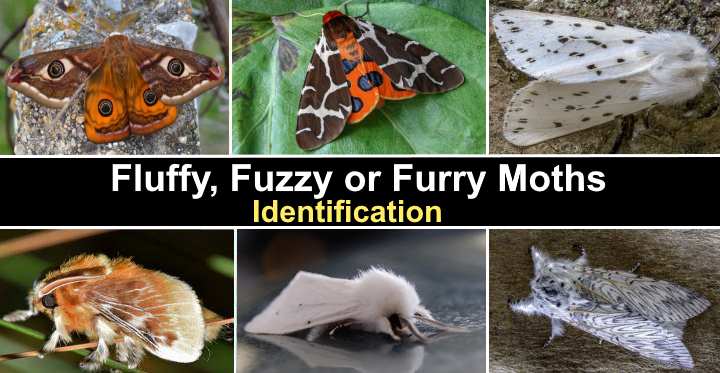
Many types of fluffy moths are some of the prettiest and most beautiful winged insects you’ll find. Fuzzy moths can be colorful insects with pink, yellow, orange, blue, and white-colored wings. Many beautiful moths have fluffy brown bodies and wings with intricate patterns that can match the beauty of butterflies. Some spectacular furry moths have eye-like markings on their wings.
This article is a complete guide to fluffy, furry, or fuzzy moths. You’ll learn that some moth species can even rival butterflies when it comes to colorful wings and beauty.
How to Identify Fluffy Moths
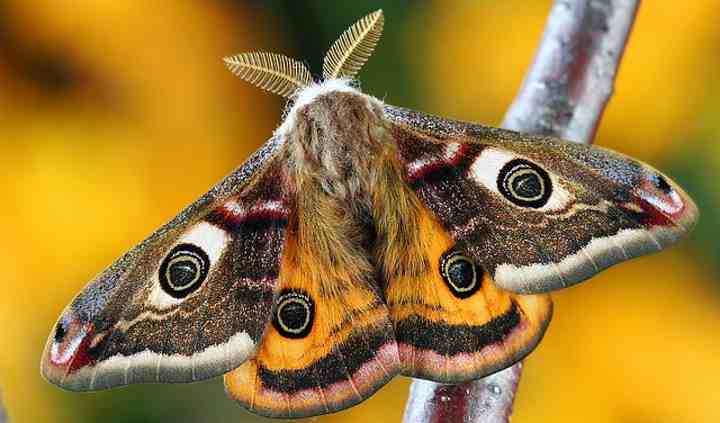
Moths can be identified by their feathery antennae, nocturnal activity and holding their wings parallel to the ground when resting
Fuzzy moths are identified by their antennae, wings, and nocturnal activity. Moths are typically easy to identify at night because they are attracted to light.
To identify a moth species, look at the type of antennae. Most fuzzy moths have feelers with tooth-like or saw-like edges that give the antennae a ragged feathery appearance. Antennae can be long and thin or short and wide, depending on the species.
You can identify moths by their four wings. Typically, when moths land on objects, they lay their wings flat, parallel to the ground. The wings may cover their body when they are resting, or they could be outstretched at their sides. Butterflies typically rest with their wings pointing upward.
Another characteristic of all moths—not just furry ones—is that they are active at night. There are only a few species of rare moths that flutter around during daylight.
Identification of Moths vs. Butterflies
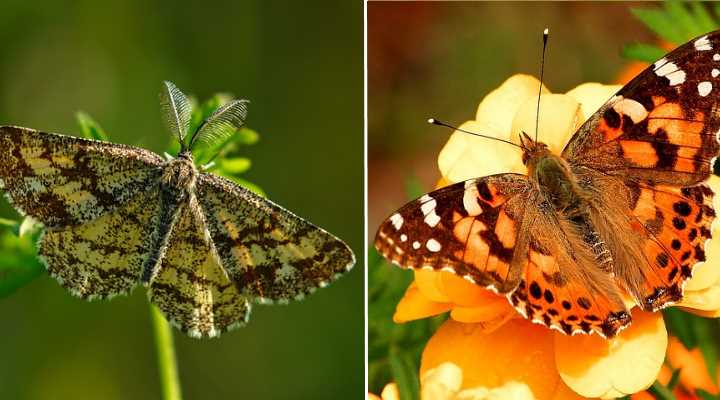
Moth antennae (left) vs butterfly antennae (right)
The primary way that butterflies and moths differ is by the shape of their antennae. Looking at close-up pictures of moths, you’ll notice that their feelers saw-edged or look like fishbones. Typically, moth antennae are feathery and thick compared to the thin feelers that butterflies have. Also, moths are nocturnal flying insects that are active from dusk until dawn.
Facts About Fuzzy Moths
All moth species are insects with four wings, two fuzzy antennae, and six legs. Like butterflies, moths belong to the insect order Lepidoptera. There are around 160,000 species of moths, compared to 18,500 species of butterflies. In North America, there are 11,000 native types of moth, many of which are brown and furry.
Fluffy moths can range in size from small furry moths about the size of your fingertip to giant colorful moths as large as your hand. The largest moth in North America is the cecropia moth (Hyalophora cecropia) that has a furry orange body and beautifully patterned wings with a wingspan of up to 7” (16 cm).
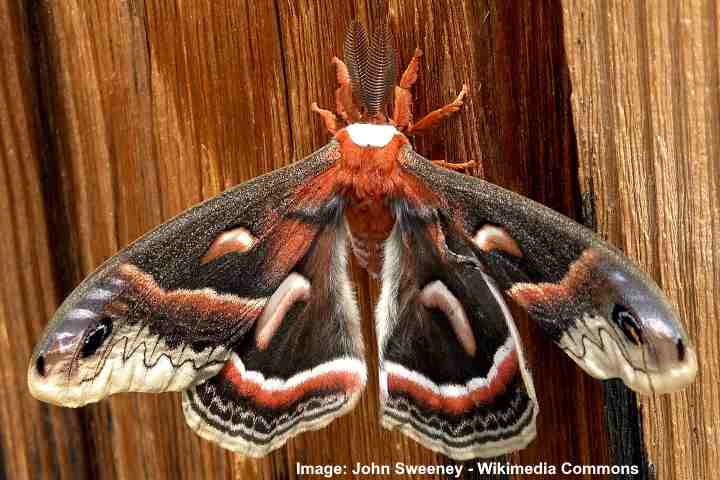
Cecropia moth is the largest native moth in North America and has small hairs all over its body
Most species of moths are divided into these five families:
Arctiidae—Brightly colored moths, many of which have the common name tiger moths.
Geometridae—A large family of moths, some of which are active during the day and can look like butterflies.
Noctuidae—A large group of moths, with many being small brown or gray furry moths.
Sphingidae—This moth family includes medium to large moths.
Saturniidae—Some of the largest furry moths are in the family Saturniidae. Silk moths and royal moths are common names of species of moths in this family.
Types of Fluffy Moths — Names, Pictures, and Identification Guide
Here is a guide to some of the prettiest moths that have a furry body or wings.
Southern Flannel Moth (Megalopyge opercularis)
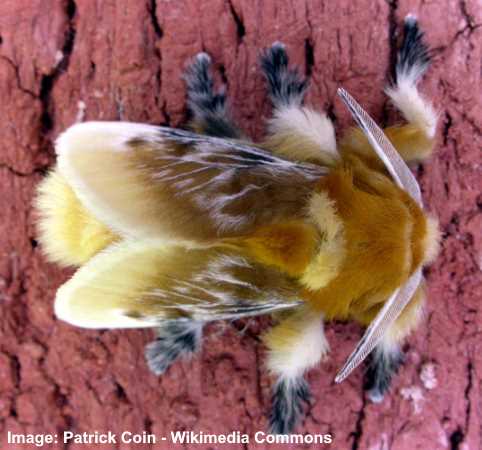
The fluffy southern flannel moth has furry body with brown wings and white edges
The southern flannel moth is a small brown furry moth with six fuzzy legs and two antennae. The “fur coat” on the moth can be dull orange, brown, or lemon yellow. An identifying feature of the southern flannel moth is its fuzzy black feet. This flannel moth measures about 1” (2.5 cm) long.
The fluffy southern flannel moth also goes by the common name puss moth. In its larval form, the flannel moth is one of the most poisonous stinging fuzzy caterpillars. The southern flannel moth caterpillar is called a woolly slug, puss caterpillar, or tree asp.
Southern flannel moth identification
Identify southern flannel furry moths by their brown-yellow hairy body, fuzzy brown and black feet, and thin feather-like antennae.
Black-Waved Flannel Moth (Megalopyge crispata)
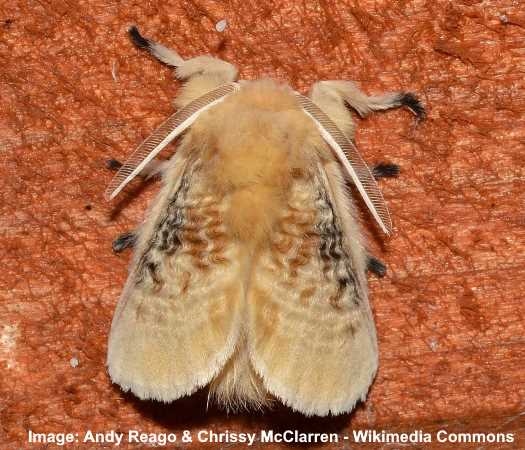
The black-waved flannel moth has hairy light brown or beige body and furry legs and is identified by the dark wave-like patterns on its forewings
The black-waved flannel moth is a light brown fuzzy moth that has furry feet and feathery antennae. To spot this fluffy moth, look for dark brown rib-like markings on its rounded forewings. This species of brown flannel moth has a wingspan of 1” to 1.5” (2.5 – 4 cm).
This attractive flannel moth is found along the east coast of North America from May until October. Like many types of flannel moths, the furry caterpillars are poisonous insects with a nasty sting.
Due to its light-brown color and patterned wings, the black-waved flannel moth has other common names, such as crinkled flannel moth or white flannel moth.
Black-waved flannel moth identification
To identify a black-waved flannel moth, look for its light tan fuzzy body and furry light brown legs with black feet.
White Flannel Moth (Norape ovina)
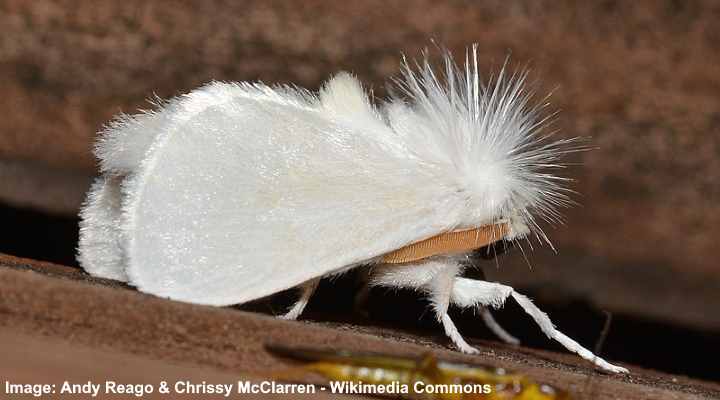
The white flannel moth can be easily recognized by its all-white fuzzy appearance
The white flannel moth is an all-white moth with silky fuzzy wings and a furry white body. Because of its snow-white appearance, this white fluffy moth is easy to spot. The fuzzy white moth has a wingspan of 1” to 1.2” (2.5 – 3 cm). You will find this cute white moth as far south as Florida, north to Washington D.C, and west to Texas.
Like all furry flannel moths, the white flannel larvae are stinging caterpillars. The crawling insects have a black body with yellow spots.
White flannel moth identification
You can identify white flannel moths by their all-white furry bodies, fuzzy white legs, and silky white wings.
Rosy Maple Moth (Dryocampa rubicunda)
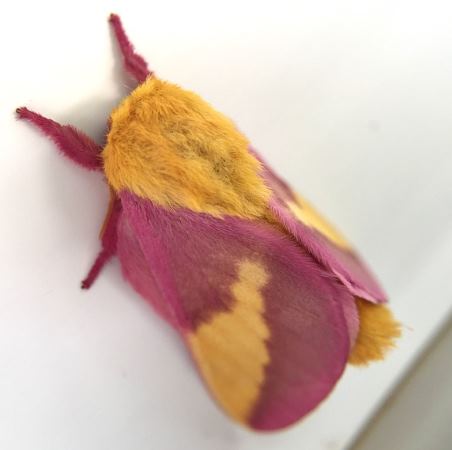
The beautiful fluffy rosy maple moth is easily identified by its colorful yellow and pink wings
The rosy maple moth is pink and yellow and one of the coolest moths you’ll see. As a small pink moth, the rosy maple has a wingspan of up to 2” (5 cm). The colorful moth is easy to spot with its bright pink and yellow coloration, bright pink fuzzy antennae, and pink furry legs.
Rosy maple moths are a type of silk moth known for their bright colors. There is also a subspecies of Dryocampa rubicunda ‘alba,’ — a furry white moth with light pink markings.
Rosy maple moth identification
The rosy maple moth has distinguishable bright yellow and pink wings with bright pink legs. They also have a yellow woolly body.
White Ermine (Spilosoma lubricipeda)

The white ermine is a pretty moth with furry head and white wings with black specks
The white ermine is a beautiful moth with pure white wings that have black speckling. The white and black wings have a wingspan of 1.2” to 2” (3 – 5 cm) with more black dots on the white forewings. Characteristics of the white ermine moth are black legs and a smooth milky-white body with brown and black markings.
White ermine moths are found in temperate regions of Europe and Asia.
White ermine moth identification
The white ermine moth is easy to identify by its fuzzy white wings with black dots, furry white head, black legs and antennae, and a smooth white body.
Large Tolype Moth (Tolype velleda)
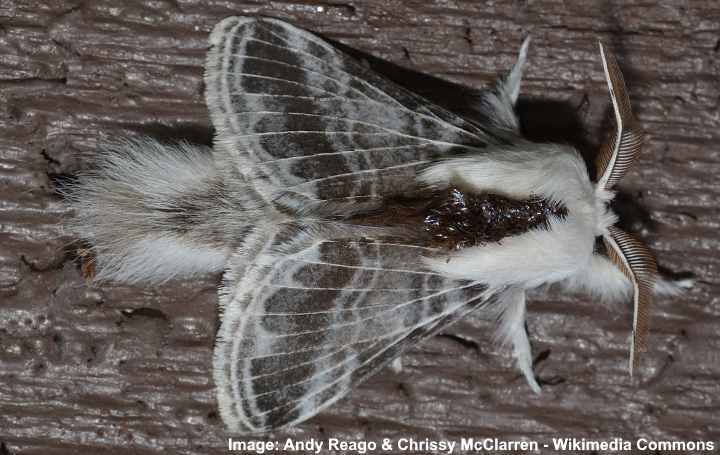
The large tolype moth has hairy body and legs with gray and white patterned wings
As the name suggests, the large tolype moth is a large furry gray moth with a long, woolly body. The characteristic features of this sizeable tolype moth are dark gray wings with white veins. You will notice the furry white head and feet and crocked fuzzy antennae.
Large tolype moths have a wingspan of 1.2” – 3” (3 – 5 cm). You will find this gray furry moth as far south as Florida, west to Texas, and as far north as Ontario.
Large tolype moth identification
To identify large tolype moths, look for dark gray wings that have white veins and edges. The large gray moth has a distinctive hairy body, giving it a soft fuzzy appearance.
Muslin Moth (Diaphora mendica)
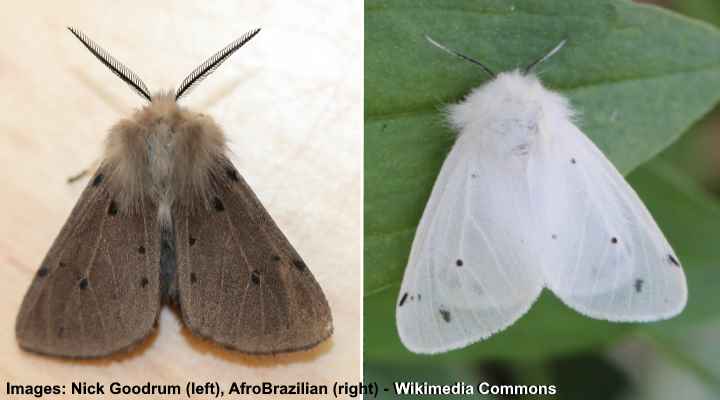
Both dark gray male muslin moth (left) and white female muslin moth (right) have furry head and body
Female muslin moths are white moths with papery-thin, almost translucent milky-white wings and black dots. A feature of muslin moths is that the males are dark-gray moths, making them easy to distinguish from the females. The white or gray moths have a wingspan of up to 1.5” (4 cm).
Muslin moths belong to the family Erebidae. The female muslin moths look like pretty white ermine moths.
Muslin moth identification
To identify muslin moths, look for the female’s translucent white wings with black speckles. When resting, the white wings are folded across the furry white body. Male muslin moths are identified by their charcoal-gray wings with black dots.
Pink-Striped Oakworm Moth (Anisota virginiensis)
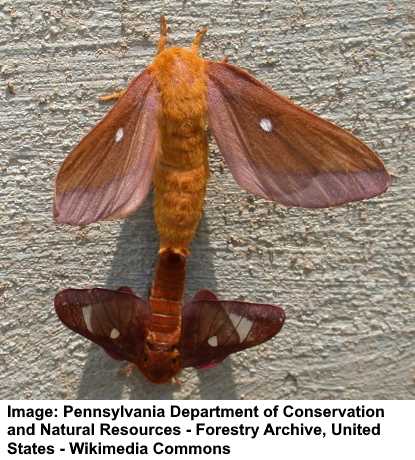
Male and female pink-striped oakworm moths mating
The pink-striped oakworm moth is a cool, orange fuzzy moth with a conspicuous orangey-white dot on each forewing. A feature of the pink-striped oakworm moth is the dark orange, plump woolly body. When resting, the brownish-orange wings are folded on the body with a space between them. This sizeable brown moth has a wingspan of 1.5” – 1.8” (4 – 6 cm).
The pink-striped oakworm is classified as a silk moth in the family Saturniidae.
Pink-striped oakworm moth identification
To identify pink-striped oakworm moths, look for the purplish and orange-brown wings with a brightly colored dot in the middle. These oakworm moths have a furry orange body with short pointed antennae.
Io Moth (Automeris io)
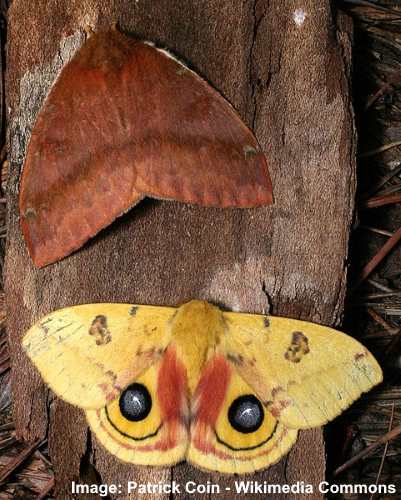
Io Moth (Automeris io): female (top) and male (bottom)
One of the coolest furry moths is the Io moth, with its brightly colored yellow wings and eye markings. The Io moth is one of the more colorful and beautiful moths you will see. The large, wedge-shaped yellow wings have brown and orange markings. The Io moth’s wingspan is 2.5” to 3.5” (6 – 9 cm).
The difference between female and male Io moths is the coloring of the furry wings. The males have bright yellow wings, whereas the females have reddish-brown or orange wings.
Io moth identification
The identifying characteristic of beautiful Io moths is the brightly colored wings with eye-like markings. Other features to identify the moth include feathery antennae and a fuzzy yellow or orange body.
White Satin Moth (Leucoma salicis)
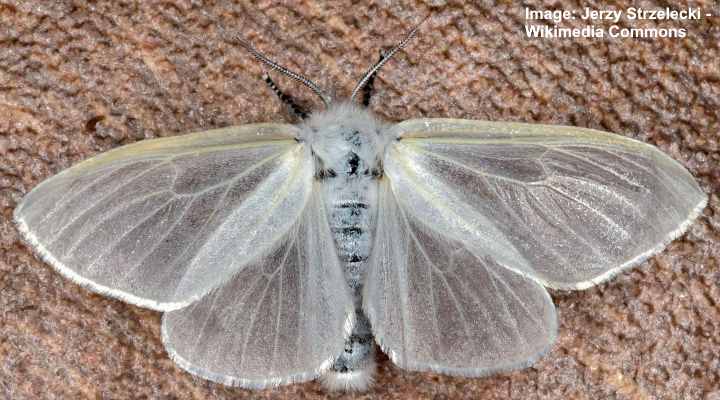
The white satin moth has furry body with translucent white wings
The white satin moth is an attractive, all-white moth with delicate translucent white wings. The beautiful white moth’s wings contrast with the black and white antennae and black head. The spectacular white satin moth has a wingspan of up to 2” (5 cm).
The white satin moth is native to Europe and Asia and belongs to the moth species Erebidae. The male moths have a wider body with creamy-white tufts on them.
White satin moth identification
To identify the white satin moth, look for its translucent slender white wings and fuzzy white body.
Puss Moth (Cerura vinula)
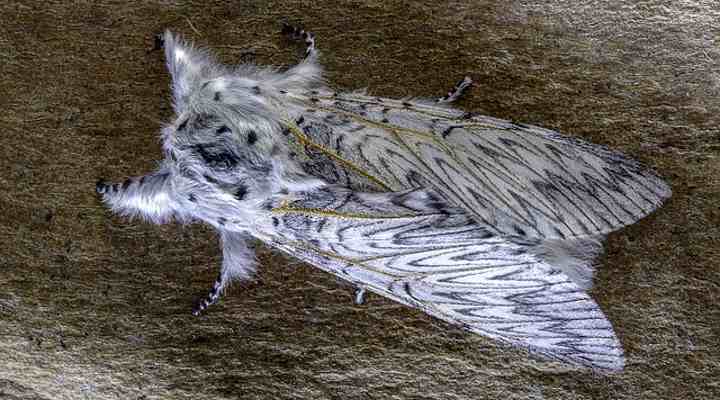
Puss moth has hairy body and beautiful gray and white marbled patterned wings
The puss moth is a cool, large gray and white moth with intricately patterned wings. This species of puss moth has a large wingspan of between 2.3” and 3” (6 – 7 cm). The moth’s head, thorax, and body are very fuzzy, resembling a cat—hence the name puss moth. The white and gray forewings are somewhat more prominent than the hindwings.
Puss moths belong to the moth family Notodontidae. Other characteristic features are the small, wiry antennae and gray and white striped furry body. Before turning into a moth, the puss moth is a type of ugly large green caterpillar.
Puss moth identification
Puss moth identification is by its furry whitish-gray body, white and gray wings with marbled patterns, and short, thin antennae.
Polyphemus moth (Antheraea polyphemus)
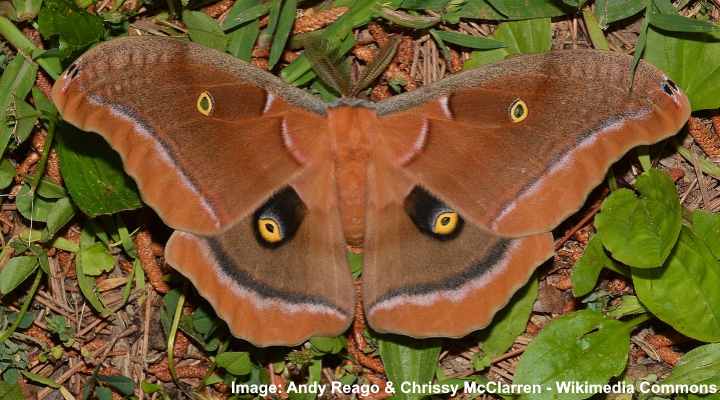
Polyphemus moth is a large furry brown moth with distinct yellow and black eye markings on its wings
The polyphemus moth is a fluffy brown moth with distinctive eye markings on each wing. This Polyphemus is one of the largest fuzzy moths in North America. Its wingspan measures up to 6” (15 cm). The large tan-colored wings also have pink, brown, and black markings—making this a beautiful type of moth.
The polyphemus moth gets its name from the wings’ eye markings from cyclops in Greek mythology. You can find this giant silk moth in almost all states in the United States.
Polyphemus moth identification
To identify the large brown polyphemus moth, look for the characteristic dark eye markings on the front and hindwings.
Blue Underwing Fuzzy Moth (Catocala fraxini)
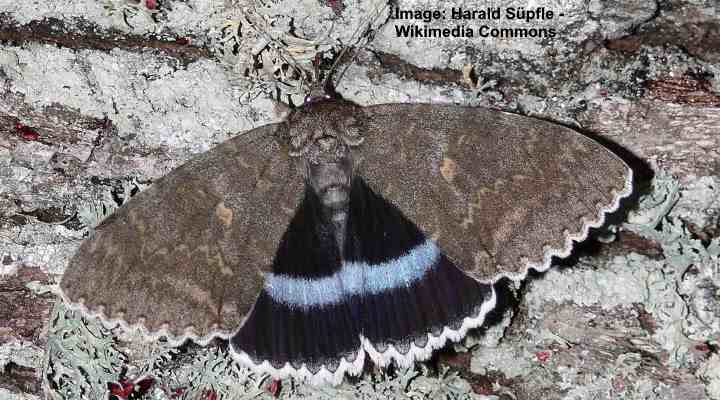
The large blue underwing moth has fuzzy body with gray forewings, dark underwings with blue band and wavy white margins
The blue underwing gray and brown furry moth gets its name from the blue band running across the dark blue hindwings. Also called the Clifden nonpareil, this moth has pale or dark gray forewings. There is also an identifiable white zig-zag margin on the wings. The very large blue underwing moth has a wingspan between 3” and 3.7” (7.5 – 9.5 cm).
The Catocala fraxini species of moth is native to Europe, Russia, and the Far East. It belongs to the family Erebidae.
Blue underwing fuzzy moth identification
The characteristic identifying features of the blue underwing moth are the grayish-brown forewings, dark blue hind wings with a blue stripe, and white margins on the wings’ base.
Emperor moth (Saturnia pavonia)
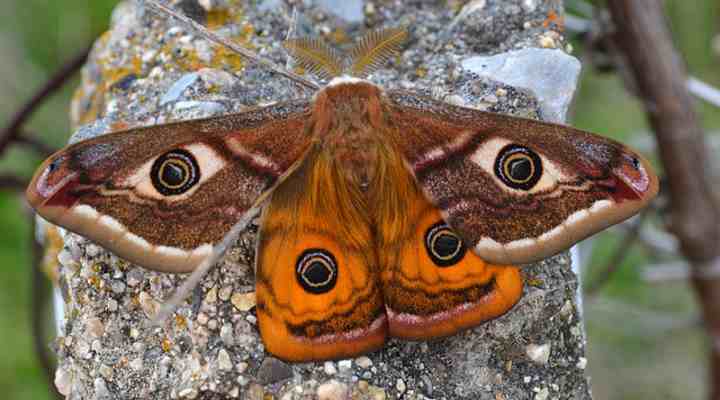
The large emperor moth is active during the day and is characterized by it hairy body and brown and orange wings with eye markings
The spectacular Emperor moth is a fuzzy, orange-brown moth with large eyespots on its large wings. Although this is not a rare moth species, it’s one of the few moths active during the day. The sizeable furry moth has a wingspan of up to 4” (10 cm) and is often mistaken for a butterfly.
You can find the emperor moth in woodlands and grasslands. The sizeable colorful moth is native to many parts of Europe. Colors on the large wings include white, pink, brown, oranges, and pinkish bands.
Emperor moth identification
The emperor moth is easy to spot due to its identifiable bright peacock eye markings on each of its four wings. The forewings are brown and white, and the hindwings are orange and brown. Each wing has colored bands.
Poplar Hawk Moth (Laothoe populi)
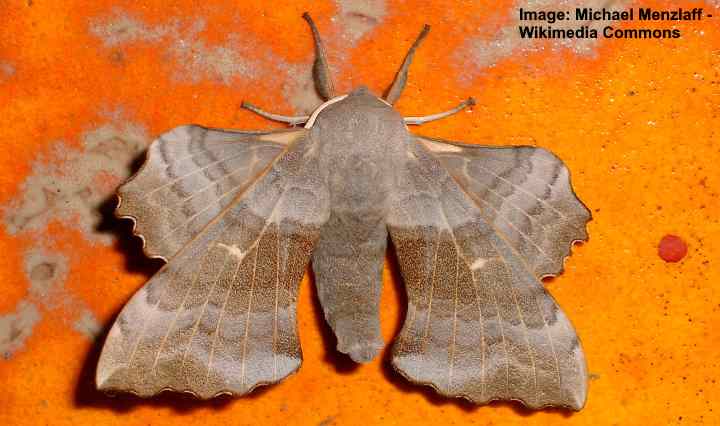
The brown-gray furry and unique poplar hawk moth rests with its hind wings forward
The poplar hawk moth is a large furry moth with wings resembling brown, yellowish, or dark gray leaves. The strange-looking moth has a wingspan of 2.7” – 4” (7 – 10 cm). An identifying feature of this unusual moth is that the wings develop a bright orange patch if the moth is startled. There is also an identifiable white spot on each forewing.
Another rare feature of the poplar hawk moth is that it rests with its hind wings forward, something that moths rarely do.
Poplar hawk moth identification
To identify poplar hawk moths, look for the large, triangular wings that have markings like watermarks. The poplar moths are also identified by their wide furry body and thin antennae. They can be challenging to spot on poplar trees because the moths look like leaves.
Garden Tiger Moth (Arctia caja)

The stunning garden tiger moth has fuzzy body and beautiful coloring and markings on its wings
Also named the great tiger moth, this moth species has unusual chocolate-brown and creamy-white patterned wings and a furry body. The cool moth has leopard-like patterns on its forewings. The two hind wings of the garden tiger moth are bright orange with large, conspicuous black dots. The garden tiger moth is so beautiful that it’s easy to mistake it for a butterfly.
The medium-sized garden tiger moth has a wingspan of 1.8” to 2.6” (4.5 – 6.5 cm). The common furry moth is found in most regions in North America.
Garden tiger moth identification
It’s easy to identify the brightly-colored hairy garden tiger moth due to its brown and white patterned forewings, orange and black-spotted hindwings, and fuzzy brown body.
Related articles:
- Types of Butterflies with Identification Guide
- Types of Green Insects – Identification Guide
- Black Beetles – Identification
